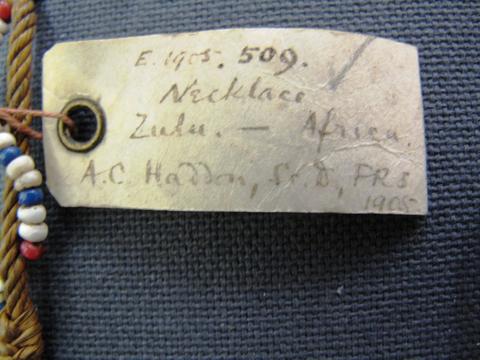Title and statement of responsibility area
Title proper
Rectangular parchment label tied to object
General material designation
- Object
- Textual record
Parallel title
Other title information
Title statements of responsibility
Title notes
- Source of title proper: Rachel Hand for MAA
Level of description
Item
Reference code
Edition area
Edition statement
Edition statement of responsibility
Class of material specific details area
Statement of scale (cartographic)
Statement of projection (cartographic)
Statement of coordinates (cartographic)
Statement of scale (architectural)
Issuing jurisdiction and denomination (philatelic)
Dates of creation area
Date(s)
-
2016 - (Online curation)
- Online curation
- Five Hundred Year Archive (FHYA)
- Note
- Digital image by Nessa Leibhammer
Physical description area
Physical description
Publisher's series area
Title proper of publisher's series
Parallel titles of publisher's series
Other title information of publisher's series
Statement of responsibility relating to publisher's series
Numbering within publisher's series
Note on publisher's series
Archival description area
Custodial history
[Source - Rachel Hand for MAA, 2016: The Museum’s catalogue cards and labels are part of the institution' and the objects' very history. Catalogue cards were created to add additional object information from the very first accessions back in 1884 and replacement cards were made if the original was lost, usually using both different pens and terms. Original sale or collector labels could be stuck to the cards to add biographical layers of information in the same way that letters and later photographs were sometimes attached to cards. Staff and sometimes visitors would add comments on provenances, measurements and locations over time. Reconnecting an author with their annotations can add to our knowledge of the object’s history and associations. The era and author of the cards also is reflected in their physical aspects: initially details were handwritten in ink, the 1930s saw cards stamped and written on a typewriter, followed variously by handwritten details in ballpoint pen, finally moving to word-processed and laser printed texts.
Like the cards the physical type of paper and pen used can suggest dates as well as authors. They can be used to confirm the identity of misplaced objects, e.g. Henry Bulwer’s collection bears distinctive long, rectangular shaped paper labels and his cursive script.
Early labels were handwritten in ink, on small rectangular paper or parchment label and tied through small metal reinforced holes. Others were glued directly to the object. Smaller rectangular or square paper labels, with a printed outline, usually stuck directly to the object, usually originate in late nineteenth or early twentieth century salerooms or via a collector. Larger circular, metal-edged labels were written in the museum, probably from the 1970s onwards. The 1980s bought larger labels on thick yellow paper, and remained handwritten. From c.2000, we have used acid-free yellowish paper labels, that are written on in light-sensitive and waterproof ink.]
Scope and content
Notes area
Physical condition
Immediate source of acquisition
Arrangement
Language of material
Script of material
Location of originals
Availability of other formats
Restrictions on access
Terms governing use, reproduction, and publication
Creative Commons License: CC BY-NC-ND
https://creativecommons.org/licenses/by-nc-nd/3.0/
Unless otherwise stated the copyright of all material on the FHYA resides with the contributing institution/custodian.
Finding aids
Associated materials
Accruals
General note
Accession numbers
[Source - Nessa Leibhammer for FHYA using MAA materials, 2012: Cat ID: 109237; ID NO: E 1905.509; MAA num: A.R.1906.805; 1905.505 on label]
General note
Attributions and conjectures
[Source - MAA, 2012:
Names: Necklace - MAA (01/12/1998)
Classified:
Keyword: Personal Adornment
Material: Grass; Glass; Bead; Fibre
Descriptions: Necklace. Woven grass, single strand decorated with twist of small beads terminating in a square bead pendant - MAA (01/12/1998)
Local:
Maker:
Cultural Group:
Author:
Date Made:
Dimensions:
Source: Haddon, A. C. (collector and donor)
Source Date:
Place: Africa; Southern Africa; South Africa; Zululand - MAA (01/12/1998)
Period:
Contexts: The colours do not appear to be Zulu, and it is unlikely that Haddon actually went to Zululand in 1905 on the expedition he undertook as part of the British Association for the Advancement of Science. Probably from the region of Swartskops Kraal, Southern Natal. From notes by Nessa Leibhammer (Curator of Traditional Southern African Collections, Johannesburg Museum & Art Gallery), 22 November 2012.
Updated: 22/07/2008
Created: 01/12/1998]
Alternative identifier(s)
Standard number area
Standard number
Access points
Subject access points
Place access points
Name access points
- Five Hundred Year Archive (FHYA) (Online curation)
- Museum of Archaeology and Anthropology, University of Cambridge (MAA) (Making)



Material contributed by members of the public
Building an archive is a collective endeavour. Please help us grow the FHYA knowledge base.
If you want to add information to this page you can insert a hyperlink, add files and/or text to the box below.
In the case of material relevant to the FHYA as a whole please upload information HERE.
The FHYA does not vet this material but reserves the right to remove anything deemed to be racist, homophobic, sexist or otherwise offensive. Everything on the FHYA is licensed under a Creative Commons CC BY-NC-ND licence.
To make a contribution you must be a registered user. To register an account, click here. Note that after registration you will not be automatically redirected to this page.
If you have already registered but are not logged in, log in here.